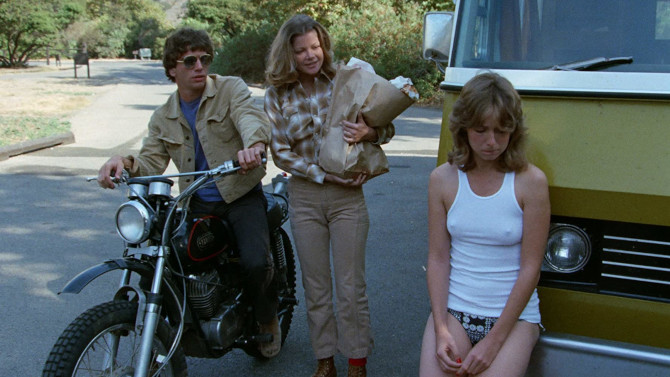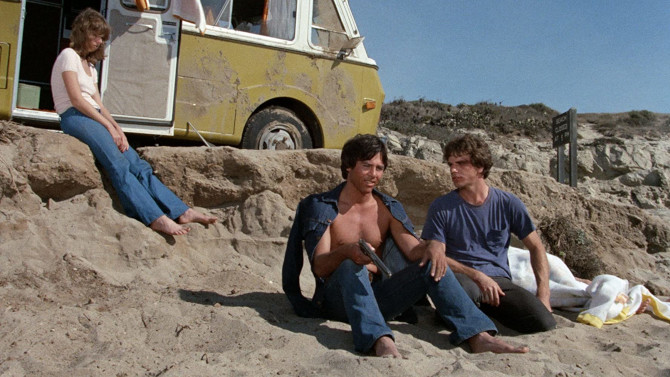‘What Could Have Been’ is a continuing look into the reels of film history, analysing movies that could have been something special, but due to problems with script, production, budgetary, or any other type of issue, did not reach its full potential.
A very Indie film that feeds off of both the buddy film craze of the time and the concluding notes of the Vietnam war, 1975’s Best Friends, written by Arnold Somkin and directed by Noel Nosseck, is exactly as it sounds, that is, until it isn’t.
Jesse (Richard Hatch) and Pat (Doug Chapin) have been best friends for years. Frick to the other’s Frack, they spend all of their time together. . . going as far as heading off to war when they are of age. Now returning from Vietnam, Jesse has set up a special surprise for his bestie – having both of their fiancées join them for an RV road trip all the way to California.

Good girl Kathy (Susanne Benton) is Jesse’s longtime loyal girlfriend, while sparkplug Jo Ella (Ann Noland) is Pat’s gal. A sort of pre-honeymoon retreat from life and the horrors of war they have lived through, it all starts off like a slice of apple pie – beautiful scenery on the open road, good meals and even better company (after all, they are young and in love), this is what road tripping should be.
But soon Pat starts acting a bit strange. Oddly attached to his best friend. . . more clingy than a wet tee shirt, the young man starts trying to convince Jesse that they should dump their significant others, buy two motorcycles, and cruise the country picking up chicks. At first thinking that this is simply some engagement jitters, Jesse shrugs it off, perhaps noticing too late the signs that something is severely wrong with his best friend.
The longer they journey, the worse things become. A bizarre concoction of post traumatic stress disorder mixed with an obsession that is only now seeping out of his subconscious, Pat continuously tinkers and prods in a rather fascinating way – somewhere between logical tactician and unhinged psychopath. Clearly understanding people (especially these three that he has known for so very long), he is not only content with breaking off his own engagement, but also turns his sights on Jesse and Kathy. . . cleverly using his former fiancée along the way.

A claustrophobic post-Vietnam character study drama that takes a slow yet dangerous turn into the realm of a thriller, Nosseck and his team of educational film makers were able to get funding to make this, their first feature film. Demonstrating the exuberance, creativity, and learn-on-the-job efforts of these mavericks, at its core, Best Friends is a quality story, yet flounders at times due to their naivety and budget (often feeling tediously slow). With the four leads working for scale, they actually found decent actors for what they paid, but at the same time, you wonder what could have been if a Ray Liotta had played Pat and a Jeff Daniels had been Jesse (throw in Melanie Griffith and I’m stealing the cast from Something Wild). Likewise, though the drama turns into a thriller, the narrative never really builds to a powder keg, a little more money and knowhow could have helped amplify the suspense and tension into something truly memorable.
Yet, despite this, there is something to be said about Best Friends. A story of its time, it provides a window into the post-Vietnam landscape, an America that on the surface is trying to look like a Leave It to Beaver world, but simmering below the surface is an unrest that has built up during the war. . . and it will forever change the country and the people within it. Also, you can already see the instinctual skill of cinematographer Stephen M. Katz (who would go on to work on iconic films like The Blues Brothers and Gods and Monsters), a zoom out that leaves the RV to focus on the mesmerizing mountain landscapes in the distance (perhaps symbolizing the rocky road to come), or the silhouettes and shadows that encage these four on the road. And, a last note – look to the poster if you want to be completely misled. . . I still have no clue what the tagline means, “She became the Ravaged Victim of a Century of Revenge!”, nor the caveat to the title (. . . until they crossed the wrong border), while the ominous Native Americans in the background play no part in the movie other than the fact there is a mini-tussle with one aboriginal as the group leave a nightclub (clearly distributor Crown International Pictures were trying to make it look like an outright exploitation picture). So, it is up to you to decide if you want to join this road trip, I’d say your choice is a shot in the dark.

